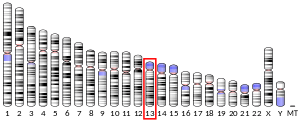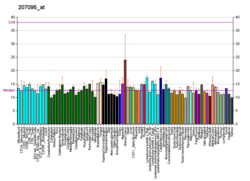SLC10A2
The SLC10A2 (solute carrier family 10 member 2) gene in humans encodes the bile acid:sodium symporter known as the apical sodium–bile acid transporter (ASBT) or as the ileal bile acid transporter (IBAT).[5][6]
ASBT/IBAT is most highly expressed in the ileum, where it is found on the brush border membrane of enterocytes. It is responsible for the initial uptake of bile acids, particularly conjugated bile acids, from the intestine as part of their enterohepatic circulation.[7]
As a drug target
Several medications to inhibit IBAT are under development. They include elobixibat, under development for the treatment of constipation and irritable bowel syndrome,[8] and volixibat, under development for the treatment of nonalcoholic steatohepatitis.[9]
See also
References
- 1 2 3 GRCh38: Ensembl release 89: ENSG00000125255 - Ensembl, May 2017
- 1 2 3 GRCm38: Ensembl release 89: ENSMUSG00000023073 - Ensembl, May 2017
- ↑ "Human PubMed Reference:".
- ↑ "Mouse PubMed Reference:".
- ↑ Wong MH, Rao PN, Pettenati MJ, Dawson PA (May 1996). "Localization of the ileal sodium-bile acid cotransporter gene (SLC10A2) to human chromosome 13q33". Genomics. 33 (3): 538–40. doi:10.1006/geno.1996.0233. PMID 8661017.
- ↑ "Entrez Gene: SLC10A2 solute carrier family 10 (sodium/bile acid cotransporter family), member 2".
- ↑ Dawson PA (2011). "Role of the intestinal bile acid transporters in bile acid and drug disposition". Handbook of Experimental Pharmacology (201): 169–203. doi:10.1007/978-3-642-14541-4_4. PMC 3249407. PMID 21103970.
- ↑ Acosta A, Camilleri M (July 2014). "Elobixibat and its potential role in chronic idiopathic constipation". Therapeutic Advances in Gastroenterology. 7 (4): 167–75. doi:10.1177/1756283X14528269. PMC 4107709. PMID 25057297.
- ↑ Chitnis D (2016-08-03), "FDA grants fast track status to volixibat", Internal Medicine News Digital Network, retrieved 2016-08-14.
Further reading
- Shneider BL (April 2001). "Intestinal bile acid transport: biology, physiology, and pathophysiology". Journal of Pediatric Gastroenterology and Nutrition. 32 (4): 407–17. doi:10.1097/00005176-200104000-00002. PMID 11396803.
- Balakrishnan A, Polli JE (2006). "Apical sodium dependent bile acid transporter (ASBT, SLC10A2): a potential prodrug target". Molecular Pharmaceutics. 3 (3): 223–30. doi:10.1021/mp060022d. PMC 2796132. PMID 16749855.
- Wong MH, Oelkers P, Dawson PA (November 1995). "Identification of a mutation in the ileal sodium-dependent bile acid transporter gene that abolishes transport activity". The Journal of Biological Chemistry. 270 (45): 27228–34. doi:10.1074/jbc.270.45.27228. PMID 7592981.
- Oelkers P, Kirby LC, Heubi JE, Dawson PA (April 1997). "Primary bile acid malabsorption caused by mutations in the ileal sodium-dependent bile acid transporter gene (SLC10A2)". The Journal of Clinical Investigation. 99 (8): 1880–7. doi:10.1172/JCI119355. PMC 508012. PMID 9109432.
- Craddock AL, Love MW, Daniel RW, Kirby LC, Walters HC, Wong MH, Dawson PA (January 1998). "Expression and transport properties of the human ileal and renal sodium-dependent bile acid transporter". The American Journal of Physiology. 274 (1 Pt 1): G157–69. PMID 9458785.
- Montagnani M, Love MW, Rössel P, Dawson PA, Qvist P (October 2001). "Absence of dysfunctional ileal sodium-bile acid cotransporter gene mutations in patients with adult-onset idiopathic bile acid malabsorption". Scandinavian Journal of Gastroenterology. 36 (10): 1077–80. doi:10.1080/003655201750422693. PMID 11589382.
- Love MW, Craddock AL, Angelin B, Brunzell JD, Duane WC, Dawson PA (December 2001). "Analysis of the ileal bile acid transporter gene, SLC10A2, in subjects with familial hypertriglyceridemia". Arteriosclerosis, Thrombosis, and Vascular Biology. 21 (12): 2039–45. doi:10.1161/hq1201.100262. PMID 11742882.
- Jung D, Fried M, Kullak-Ublick GA (August 2002). "Human apical sodium-dependent bile salt transporter gene (SLC10A2) is regulated by the peroxisome proliferator-activated receptor alpha". The Journal of Biological Chemistry. 277 (34): 30559–66. doi:10.1074/jbc.M203511200. PMID 12055195.
- Zelcer N, Saeki T, Bot I, Kuil A, Borst P (January 2003). "Transport of bile acids in multidrug-resistance-protein 3-overexpressing cells co-transfected with the ileal Na+-dependent bile-acid transporter". The Biochemical Journal. 369 (Pt 1): 23–30. doi:10.1042/BJ20021081. PMC 1223054. PMID 12220224.
- Chumakov I, Blumenfeld M, Guerassimenko O, Cavarec L, Palicio M, Abderrahim H, et al. (October 2002). "Genetic and physiological data implicating the new human gene G72 and the gene for D-amino acid oxidase in schizophrenia". Proceedings of the National Academy of Sciences of the United States of America. 99 (21): 13675–80. doi:10.1073/pnas.182412499. PMC 129739. PMID 12364586.
- Neimark E, Chen F, Li X, Shneider BL (July 2004). "Bile acid-induced negative feedback regulation of the human ileal bile acid transporter". Hepatology. 40 (1): 149–56. doi:10.1002/hep.20295. PMID 15239098.
- Xia X, Roundtree M, Merikhi A, Lu X, Shentu S, Lesage G (October 2004). "Degradation of the apical sodium-dependent bile acid transporter by the ubiquitin-proteasome pathway in cholangiocytes". The Journal of Biological Chemistry. 279 (43): 44931–7. doi:10.1074/jbc.M400969200. PMID 15304498.
- Zhang EY, Phelps MA, Banerjee A, Khantwal CM, Chang C, Helsper F, Swaan PW (September 2004). "Topology scanning and putative three-dimensional structure of the extracellular binding domains of the apical sodium-dependent bile acid transporter (SLC10A2)". Biochemistry. 43 (36): 11380–92. doi:10.1021/bi049270a. PMID 15350125.
- Banerjee A, Ray A, Chang C, Swaan PW (June 2005). "Site-directed mutagenesis and use of bile acid-MTS conjugates to probe the role of cysteines in the human apical sodium-dependent bile acid transporter (SLC10A2)". Biochemistry. 44 (24): 8908–17. doi:10.1021/bi050553s. PMID 15952798.
- Nakahara M, Furuya N, Takagaki K, Sugaya T, Hirota K, Fukamizu A, Kanda T, Fujii H, Sato R (December 2005). "Ileal bile acid-binding protein, functionally associated with the farnesoid X receptor or the ileal bile acid transporter, regulates bile acid activity in the small intestine". The Journal of Biological Chemistry. 280 (51): 42283–9. doi:10.1074/jbc.M507454200. PMID 16230354.
- Bergheim I, Harsch S, Mueller O, Schimmel S, Fritz P, Stange EF (January 2006). "Apical sodium bile acid transporter and ileal lipid binding protein in gallstone carriers". Journal of Lipid Research. 47 (1): 42–50. doi:10.1194/jlr.M500215-JLR200. PMID 16237211.
- Banerjee A, Swaan PW (January 2006). "Membrane topology of human ASBT (SLC10A2) determined by dual label epitope insertion scanning mutagenesis. New evidence for seven transmembrane domains". Biochemistry. 45 (3): 943–53. doi:10.1021/bi052202j. PMC 2525805. PMID 16411770.
This article incorporates text from the United States National Library of Medicine, which is in the public domain.




